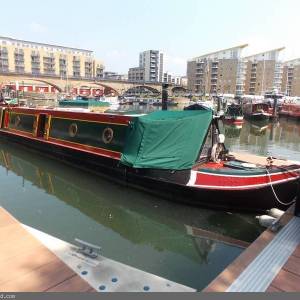
5 Things You Should Know Before Living Aboard
A love of canals and waterways may eventually lead you to take up the liveaboard way of life. The romance of sparkling water, willow trees, ducks and swans is enticing in summer, and cosy spirals of smoke from the chimneys of glowing stoves are inviting in winter. For some it is just a daydream, but for those who are serious about a life afloat it’s best to do a little research first. Our free eBook Living on a Boat covers all the basics such as finding a mooring, continuous cruising, finance and insurance. Here are five extra tips if you’re thinking of buying aboat to live on.
1) Research Your Budget
Consider licence fees, mooring fees, maintenance costs, diesel and coal. Mooring fees vary drastically depending on their geographic location, with central London being one of the most expensive areas to live forexample. The Narrowbudget software may be helpful: a free online budget calculator designed specifically for narrowboat owners.
2) Cruising Guidelines
Don’t assume that becoming a continuous cruiser is an easy way to avoid mooring fees. The Canal and River Trust has detailed guidelines that require a boat to relocate every 14 days. Continuously cruising for 365 days a year in all weathers can be a challenging lifestyle, so don’t jump into it without investigating thoroughly.
3) Mail on the Move
If you’re not in a residential marina that can receive your ‘snail mail’ there are various others ways to receive your post while travelling the canals. Most main post offices will accept Post Restante Mail to be collected at a later date, if it bears the recipients full name and ‘C/O Post Restante,Post Office X’. There is no charge for the service but it is a temporary one, to be used for only a few weeks while you are travelling in the area. Unclaimed post will be returned to the sender. See our article: 5 Ways for Boaters to Receive Snail Mail.
4) Earning a Living
If you’d like to run a business from your boat, selling goods or services you will need a roving traders licence. There is a growing and vibrant community of roving traders living aboard, selling everything from painted Buckby cans, to cheese, jewellery, fenders, diesel and coal. If you’re serious about starting a floating business the Roving Canal Traders Association is a useful resource.
5) Get a Survey
Boatshed can provide you with a list of marine surveyors but we are not permitted to recommend one in particular. The vessel will be craned out of the water in a boatyard at the buyer’s expense. While a professional survey can include a detailed report on the electrics, cabin fittings, appliances etc., the most important element of the report will be the condition of the hull. You may like to read: 3 Things You Must Know Before Survey.
When you’ve absorbed all of that information I’d say you are more than ready to go ahead and begin viewing boats for sale. Use our flexi search facility to quickly filter the complete Boatshed.com stock list to show boats that most interest you.
Featured image:
Narrowboat 57ft Trad with London Residential Mooring
Peggy Melmoth
You may also like:
Living on a Boat: The Boatshed Guide (free) / How to Sell a Boat: The Ultimate Guide (free eBook) / How to Buy a Boat: The Ultimate Guide / The best blog articles of 2013 / Don’t miss:The Boatshed Grand Union Daily/ More articles.
New here? Come and say 'hello' on Facebook or Twitter :-)
Never miss an article: Sign up and get the latest blog articles sent directly to you, plus instantly receive our free eBook: How to Sell a Boat: The Ultimate Guide.

